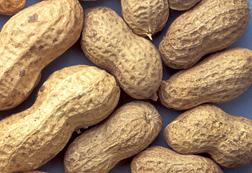This page has been archived and is being provided for reference purposes only. The page is no longer being updated, and therefore, links on the page may be invalid.
| Read the magazine story to find out more. |
|
|
|
|
Moisture Meter Technology for In-shell Peanuts Licensed
By Rosalie Marion Bliss
August 21, 2014
A new meter that measures the moisture of peanuts inside the shell has been developed by U.S. Department of Agriculture (USDA) scientists and licensed by a manufacturer of instruments for use in agriculture. The moisture-sensing meter was invented by Agricultural Research Service (ARS) engineers Samir Trabelsi and Stuart O. Nelson (retired) in the ARS Quality and Safety Assessment Research Unit at Athens, Georgia.
ARS is USDA's chief intramural scientific research agency, and this research supports the USDA priorities of promoting international food security and ensuring food safety.
Peanuts need to be dried to a kernel moisture content of less than 10.5 percent for storage purposes because higher moisture levels can lead to fungal growth. The meter is based on patented low-power microwave sensing technology and an algorithm that produces a crop-specific moisture calibration equation, also developed by Trabelsi. The equation is used to customize an individual meter for use with a specific crop type.
When a sample material is exposed to microwaves, part of the wave is transmitted and part is reflected, providing the individual "electrical signature" of the sample material being tested. The patented calibration method uses this information to produce a moisture calibration equation that is programmed into the meter.
U.S. peanuts are required by the USDA to be inspected at local peanut "buying points," and farmers take their peanuts there to be weighed, cleaned, inspected, graded, and ultimately purchased. During peanut grading, inspectors determine quality factors such as peanut size, shell size, peanut damage, levels of foreign material, , and kernel moisture levels. If the kernel moisture level is too high, the sample is marked "no sale," and the corresponding lot of peanuts has to be further dried.
Trabelsi worked under an agreement with Dickey-John Corporation, based in Auburn, Illinois, a wholly owned subsidiary of TSI Incorporated, based in Shoreview, Minnesota, to build a working prototype of the latest version of the patented in-shell peanut moisture sensor. Marketing research and evaluations are being conducted to get a better sense of what more is needed to bring the meter to commercial markets, according to Beau Farmer, chief technology officer with TSI.
Read more about this research in the August 2014 issue of Agricultural Research magazine.

